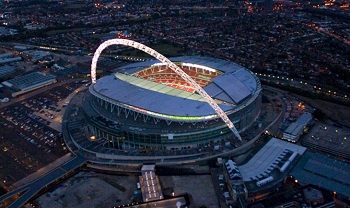Wembley Stadium

Wembley Stadium is the home of English football. The original stadium was first built for the British Empire Exhibition of 1924 but became the most important sports and entertainment venue in Britain, serving as the focus for the 1948 Olympics, the 1966 World Cup and the 1996 European Championships. Plans for a new stadium were officially unveiled in July 1998. The stadium design was said to offer "vastly improved facilities, superb spectator views and a huge arch, to replace the towers.
England penned the worst possible final page in old Wembley's history books when they lost 0-1 to Germany on 7th October 2000 in a World Cup qualification game which culminated in the departure of Kevin Keegan as team manager.
Bulldozers moved in to start the job of replacing the stadium in September 2002 with Work on demolishing Wembley's famous twin towers beginning in February 2003.
Following its £757 million redevelopment, the new stadium opened officially in May 2007 for the FA Cup Final which still provides the highlight of Wembley's annual calendar of events.
With 90,000 seats and covering twice the area of the original, the new stadium is the largest covered arena in the world. At its highest point, the iconic arch is more than four times the height of Wembley's original Twin Towers.
Facilities are designed to maximise spectator enjoyment; seats are larger than the old ones, with more leg-room; the highest tiers are easily accessed via escalators; and the concourse that wraps around the building provides catering for up to 40,000 spectators at any one time. One of the things that make the stadium special is the retractable roof, which ensures that the spectator experience is comfortable in all weathers.
When the roof is open it ensures that the turf gets sufficient sunlight and air to maintain perfect condition, while in bad weather it can be closed to cover the entire seating area. The spectacular 133-metre-high arch which supports the stadium roof was designed to provide an iconic replacement for the old building’s twin towers; conceived as a triumphal gateway, floodlit at night it is a strong symbol for the new Wembley and a new London landmark.
The stadium is designed to be ideal for football. Its geometry and steeply raked seating tiers ensure that everyone has an unobstructed view. To recreate the intimate atmosphere and the distinctive ‘Wembley roar’ for which the old stadium was famous, the seats are located as close to the pitch as possible. Yet the building has also been consciously ‘future proofed’, with the ability to host a variety of events, including international track and field events to Olympic standard if required.
The stadium boasts 2,618 toilets, thought to be more than any other stadium in the world.
Location
Wembley Stadium
Wembley National Stadium Ltd
Wembley
HA9 0WS
Getting There
Nearest railway station: Wembley Stadium
Nearest Tube / Rail Station
Wembley Park (Zone 4)
Wembley Central (Zone 4) - Bakerloo Line
